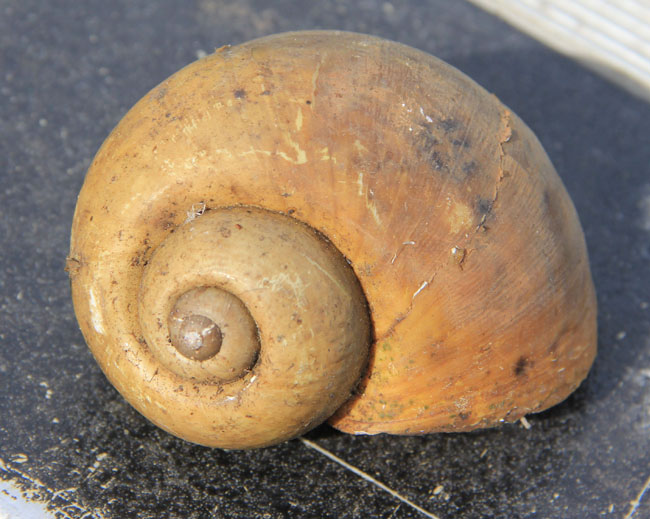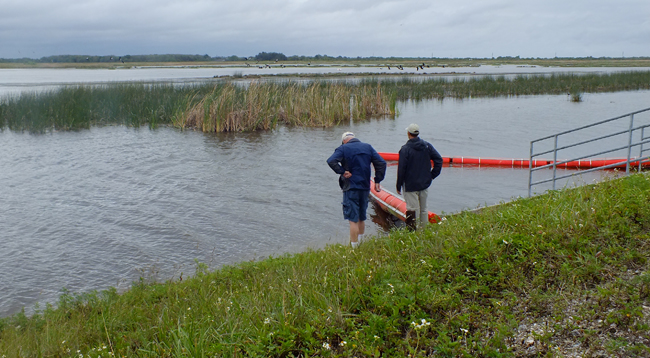Apple Snails Offer Conflicting Tales
By Marina Cinami
Small, bright pink eggs grow in clumps at the base of large, damp leaves in swampy areas of the Everglades. These are the eggs laid by exotic apple snails.
For an endangered bird called the snail kite, the exotic apple snail is a savior. But for others the invasive snail is a nuisance and an environmental hazard.

Photo by Kaitlyn Carroll
Linda Friar, public information officer of Everglades National Park, says this invasive snail likely came to Florida via shipping and cargo. They consume the same food as native apple snails, thus threatening the existence of the native population.
But Paul Gray, science coordinator of Audubon Florida, sees this invasive species as greatly beneficial in aiding the existence of the snail kite.
From 1999 to 2009 the snail kite population plummeted from about 3,500 to 700 as a result of several years of drastic flooding and droughts that wiped out the endemic apple snail population. “We went 10 years without seeing one, it’s just a miracle that they’re coming back,” he says.
In 2008 and 2009, the exotic apple snails arrived in the Everglades, quite literally saving the snail kite population. Gray says the exotic apple snails, also known as giant apple snails, are much larger than the endemic species and lay ten times as many eggs. They are a much sturdier breed of apple snail, as they can live up to a year in the mud through droughts and bad weather. Gray says they’ve proven to be “bullet-proof” to the drastic, man-made changes in water level that helped to nearly wipe out the native apple snail population.
The exotic apple snails may have been beneficial for the snail kite, but they are a headache for others such as the South Florida Water Management District, which runs expansive fields called storm water treatment areas (STAs). The agency uses STAs to reduce hazardous levels of phosphorous in the water caused by pollution from farms and other developments. Last year the exotic apple snails had a “population explosion” in one STA “cell,” or designated area. The SFWMD’s progress in removing phosphorous was set back significantly.
Storm water treatment areas use vegetation such as cattails and pickerel weed to absorb the excess phosphorous in the water, which comes from runoff from farms and industrial plants. This phosphorous is damaging to the Everglades unique fragile, low-nutrient ecosystem.
Invasive and usually unwanted plant species like cattails and pickerel weeds are used in storm water treatment areas because they absorb a much higher amount of nutrients, including phosphorous, than native Everglades plants. The invasive plants absorb and then store the phosphorus as they decay.
Gray explains that when the exotic apple snail population drastically rose, the overwhelming number of exotic snails ate nearly all of the vegetation that had been helping to rid the water of phosphorous.
Nathan Ralph, a scientist with the South Florida Water Management District, says the exotic snails “devastated” one treatment area last summer. When he first saw the damage, he was surprised but he thought “whoa, we have to do something.” The problem was, they didn’t know what to do. They could only wait for it to end, observing and documenting the incident as it happened before them.

Photo by Zarrin Ahmed.
From this one snail population spike, the STA cell that had been down to the nearly acceptable level of 30 ppb (parts per billion) of phosphorous rose to 130 ppb. Ralph says that luckily, the eat-out wasn’t too catastrophic, but it did add additional unanticipated costs in order to bring in new plants to colonize the damaged cell. He says such ecological developments aren’t much of a surprise for the SFWMD, which is used to repairing damage done after each rainy season. It’s “part of the nature of the beast,” Ralph says.
The exotic apple snail is known for causing such problems in other areas where it has made a home for itself, like Hawaii and southeast Asia. Gray says the incident last year was Florida’s first experience and it’s still uncertain if it will become a recurring habit of the species’ Everglades population. Ralph is not expecting it, though. “To date, we haven’t seen the egg clusters or the amount of active snails as we did that summer,” he says. “It was impressive.” In the devastated cell, Ralph says the SFWMD is currently trying to add in new plants to replace those that were eaten.
Because of this incident, however, as well as the general goal of naturalists and activists to protect endemic species and avoid incorporating exotics, the eggs of exotic apple snails are being systematically removed by scientists and volunteers within Florida national park properties in the hopes of reducing the population. The eggs are easily accessible in the marsh areas, which helps with the removal process. Shauna Cotrell, a ranger at Everglades National Park, says the effort appears successful because the eggs have not been significantly spreading.
The increases in the snail kite population have leveled off in the last few years and Gray has begun to wonder if the exotic apple snails may not be as dependable a food source for the kites as was first believed. The invasive species is still being studied and monitored, and time will tell if the bright clusters of pink eggs in the Everglades’ marshes will bring more help or harm to the ecosystem.